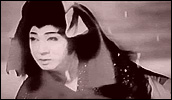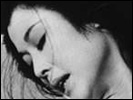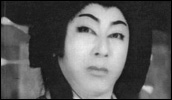An Actor’s Revenge
- Year
- 1962
- Original title
- Yukinojo Henge
- Japanese title
- 雪之丞変化
- Director
- Cast
- Running time
- 108 minutes
- Published
- 10 March 2003



by Jasper Sharp
Since his debut, the twenty-minute long animated bunraku doll drama A Girl at Dojo Temple (Musume Dojoji, 1945 - long believed lost after being banned by the US Occupational Authorities for its "traditional" subject matter, but actually still extant), the late Kon Ichikawa achieved the remarkable feat of sustaining a steady cinematic output throughout each of the successive seven decades. His last film, a remake of his own 1970s hit caper The Inugamis (Inugami-ke no Ichizoku) was released in Japan in 2006.
Despite this however, until recently the director has rather fallen beneath radar detection from the international film community; partially due to the lack of easily detectable themes, techniques or adherence to any one particular style or genre in his body of work making him an unsuitable for appraisal in the auteurist sense of the word; partially due to the relative low-key anonymity as studio products of much his work (not to mention the low quality of a good proportion of his later output, such as the needless 1985 remake of his 1956 classic, Harp of Burma); partially through a characteristic myopia of Western film critics unable to see beyond Kurosawa, Ozu and the usual suspects; and partially to the tiny fraction of his 70+ film oeuvre that has actually made it overseas. Then in 2001 a full-blown retrospective was organised by the Cinematheque of Ontario, with an informative accompanying book edited by James Quandt, which went on to travel through a number of North American locations before ending up in the United Kingdom in 2002.
At the tail end of this comes the British Film Institute's DVD release of, for UK audiences at least, one of Ichikawa's best known films, An Actor's Revenge, a film which has already had a volume in the "BFI Film Classics" series of books devoted to its analysis and was available on VHS in Britain for quite some time during the 90s. Set in the heart of 19th century Edo, the story concerns proud Kabuki actor Yukinojo, an oyama, (or onnagata, an actor of female roles in the all-male world of kabuki) on tour to the capital as part of a visiting troop from Osaka. After espying from the stage the magistrate who indirectly caused the death of his parents many years before, he sets in motion a plan to take revenge using all the skills of guile and persuasion of his craft, not only against the magistrate Sansai Dobe himself, but also Dobe's two merchant associates Kawaguchiya and Hiromiya. To this end, Yukinojo's plan is doubly assisted when Dobe's daughter, Namiji, falls in love with him after seeing him on stage.
The story has it that Ichikawa was assigned this project by Daiei as a punishment for the studio's lack of satisfaction with his previous three productions, Conflagration (Enjo, 1958), Bonchi (1960) and The Outcast (Hakai, 1962). Intended as a vehicle to mark the 300th film appearance of Kazuo Hasegawa, possibly the most famous screen actor of the period, with a career stretching back into the silent era, Daiei chose to dust down a creaky old melodrama in which Hasegawa had starred some twenty five years before.
The original Yukinojo Henge, produced by Shochiku in 1935, had been directed by Teinosuke Kinugasa, the prolific director whose A Page of Madness is surely one of the most pressing cases in Japanese cinema for a DVD treatment at the moment. Kinugasa had worked with Hasegawa many times both before and after the original version of Yukinojo Henge, with the period epic Gate of Hell (Jigokumon) being the only example of their work together released in the West. Both Kinugasa and Hasegawa had a background in theatre, and like the main character of Yukinojo Henge, both had acted on stage in oyama roles. Kinugasa himself had been one of the most famous screen "actresses" up until the 1920s, and then Nikkatsu started hiring real women to appear onscreen and he moved to the other side of the camera. The original script, based on a newspaper serial by Mikami Otokichi, was adapted by Kinugasa along with another seminal figure from the silent days, Daisuke Ito (director of, amongst others, Chuji's Travel Diary, 1927).
For the remake, the foremost obstacle was in the casting of Hasegawa in a role which he'd originally played when he was half the age. Would the now 55 year-old actor still be able to convincingly pull off such blatantly ridiculous scenes in which, dressed as a woman (as he is throughout the entire film, both onstage and off), with his trademark flutey voice, he courts his admirer Nemiji? Sensibly Ichikawa, using a script adapted from the original by his wife and constant collaborator up until the mid-60s, Natto Wada (pen name for Yumiko Ichikawa), doesn't even try. Instead, he opts for a style which falls only just slightly shy of pure camp, burying such shortcomings as the hackneyed narrative arc beneath a thick pop art veneer, melding a host of new cinematic techniques with constant theatrical nudges to the viewer that break with the sacred fourth wall convention of screen drama, all laid down to a score that alternates between traditional Japanese music and sultry 60s jazz.
It is the painterly way in which Ichikawa handles the dimensions of the widescreen Cinemascope format that will no doubt form the most lingering impression on most viewers. In one shot, two thieves tug on a piece of rope that extends from one end of the frame to and beyond the other side. There's a hypnotic sword fight set against a plain black backdrop, and in other such heavily stylised scenes as Yukinojo's initial appearance in the midst of an onstage snow storm as the faces of his persecutors appear superimposed in oval irises, Ichikawa bowls us with his eclectically cobbled together melange of jarring cinematic techniques and a lush and vivid colour palate.
Hasegawa is ably supported by a cast of Daiei's finest of the time, with a very young and beautiful Ayako Wakao, star of many of Yasuzo Masumura's (assistant director to Ichikawa for a couple of films in the late-50s, and by all accounts none too enamoured with his mentor's style) films for Daiei (Manji, Red Angel) playing Nemiji, and cameos from two of chambara's greatest, the late great Shintaro "Zatoichi" Katsu, and Raizo Ichikawa, star of the Shinobi No Mono / Band of Assassins series of classic ninja films. Also worth mentioning, in the role of narrator, is Musei Tokugawa, formerly one of the most influential benshi film narrators of the silent film period.
All of these factors lend the film a great deal more interest and significance than the serviceable plot perhaps warrants, and certainly An Actor's Revenge is a film whose reputation has been hoisted far higher abroad than in its country of origin. For those with a taste for the kabuki aesthetic, it should certainly provide a heady brew, possessing all the requisite orientalist elements to have had most westerners wide-eyed in wonder at the time of its first screenings abroad - a uniquely Japanese "traditional" theme and setting, and an eclectic and inventive visual style marked out by vibrant colours and masterly pictorial composition. But dramatically it never quite engages to its fullest potential.
Nevertheless, whilst hardly the masterpiece some would have us believe, at least two factors make Ichikawa's film's resurrection on DVD a worthy endeavour. Firstly, as already mentioned, it looks absolutely beautiful. More than that however, the idiosyncratic background and the wealth of talent involved in the production ensure that Ichikawa's film provides a fine snapshot of what was going on at the tail end of what was considered a Golden Age of Japanese cinema. An Actor's Revenge provides as welcome an entry point as any other into Ichikawa's broad and distinctive oeuvre.